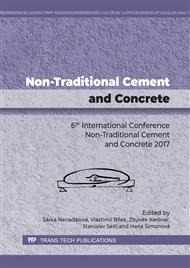[1]
ATSDR, Agency for Toxic Substances and Disease Registry. 2011: Substance Index for Tox FAQs. United States, Information on http/www. atsdr. cdc. gov/toxfaqs/index. asp.
DOI: 10.4135/9781412963855.n24
Google Scholar
[2]
A. Lassin, et al., Reactivity of waste generated during lead recycling: an integrated study, J. of Haz. Mat. 139 (3)(2007) 430-437.
Google Scholar
[3]
U.S. Geological Survey, Mineral commodity summaries, United States: Geological Survey, (2008).
Google Scholar
[4]
D. Rodríguez - López, Lead slags leachability characterization: a critical study with different laboratory assays, Proceedings of the Third Regional Forum of energy and the Environment, Brasil, (1999).
Google Scholar
[5]
S. Hreglich, et al., Inertisation of slags from the treatment of end of life automotive batteries and their reuse in the production of heavy clay products with soundproofing properties, Glass Tech.: European J. of Glass Science and Technology Part A. 49 (6) (2008).
Google Scholar
[6]
A. Smaniotto, et al., Qualitative lead extraction from recycled lead-acid batteries slag, J. of Haz. Mat. 172 (2009) 1677-1680.
DOI: 10.1016/j.jhazmat.2009.07.026
Google Scholar
[7]
Y. Shu, Ch. Ma, L. Zhu, H. Chen, Leaching of lead slag component by sodium chloride and diluted nitric acid and synthesis of ultrafine lead oxide powders, J. of Pow. Sour. 281 (2015) 219-226.
DOI: 10.1016/j.jpowsour.2015.01.181
Google Scholar
[8]
B. Coya, , E. Marañon, H. Sastre, Ecotoxicity assessment of slag generated in the process of recycling lead from waste batteries, Res. Cons. and recyc. 29 (2000) 291-300.
DOI: 10.1016/s0921-3449(00)00054-9
Google Scholar
[9]
M. Frías, M. Sánchez de Rojas, O. Rodríguez,: Novedades en el reciclado de materiales en el sector de la construcción: Adiciones puzolánicas II, Jornadas de investigación en Construcción, Madrid, 2008, 1415-1424.
DOI: 10.4067/s0718-915x2012000300001
Google Scholar
[10]
M. D. Lagrega, P. L. Buckingham, J. C. EVANS, Hazardous wastes management, New Jersey, (1994).
Google Scholar
[11]
G. De Angelis, et al, Reuse of residues arising from lead batteries recycle. A feasibility study, J. Was. Man. 22 (2002) 925-930.
DOI: 10.1016/s0956-053x(02)00082-x
Google Scholar
[12]
M. Penpolcharoen, Utilization of secondary slag as construction material, Cem. and Conc. Res. 35 (2005) 1050-1055.
Google Scholar
[13]
N. Saikia, et al, Assessment of Pb-slag, MSWI bottom ash and boiler and fly ash for using as a fine aggregate in cement mortar, J. of Haz. Mat. 154 (2008) 766-777.
DOI: 10.1016/j.jhazmat.2007.10.093
Google Scholar
[14]
R. Mejía de Gutiérrez, P. Rodríguez, Durabilidad y corrosión en materiales cementicios, Costa Rica: CYTED, (1999).
Google Scholar
[15]
F. Massazza, Pozzolanic Cements, Cem. and Conc. Comp. (1993) 185-214.
Google Scholar
[16]
L. Gurtubay, G. Gallastegui, A. Elías, A. Barona, S. Fernandez, Evaluación de la lixiviación natural de una escoria negra de acería sometida a un proceso de envejecimiento acelerado por carbonatación, XVI Congreso Internacional de Ingeniería de Proyectos, Valencia, (2012).
DOI: 10.26439/ciis2019.5502
Google Scholar
[17]
C. R. Vargas, C. M. Cifuentes, Tratamiento hidrometalúrgico para la Recuperacion de plomo desde borras anódicas con EDTA. VIII Simposio Internacional de Qualidade Ambiental: Porto Alegre, (2012).
Google Scholar


